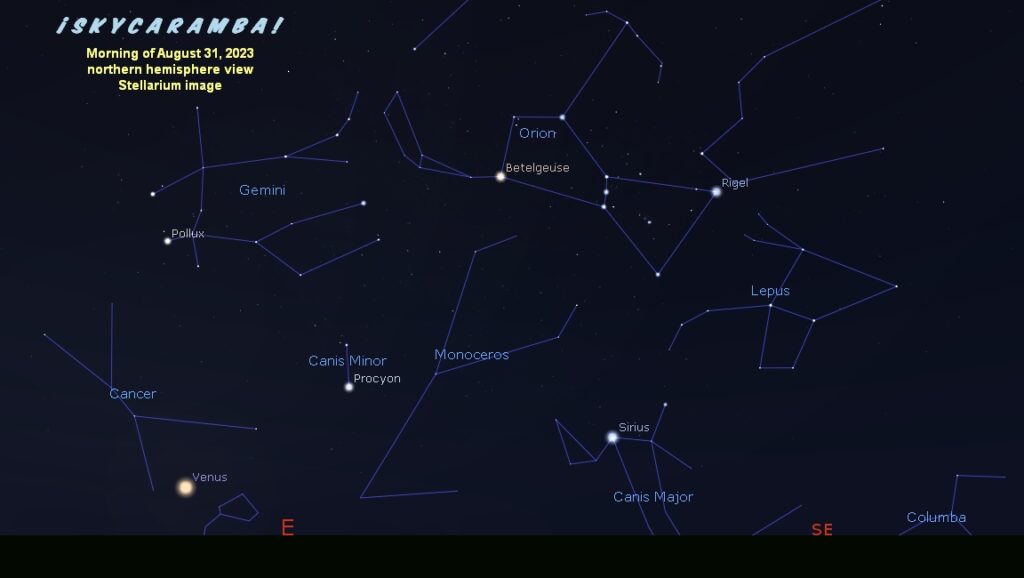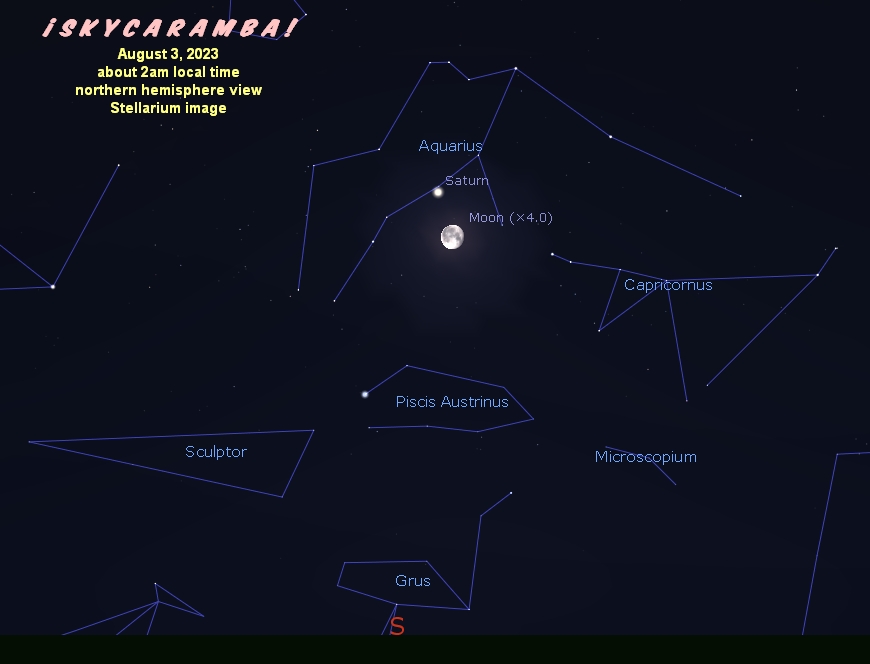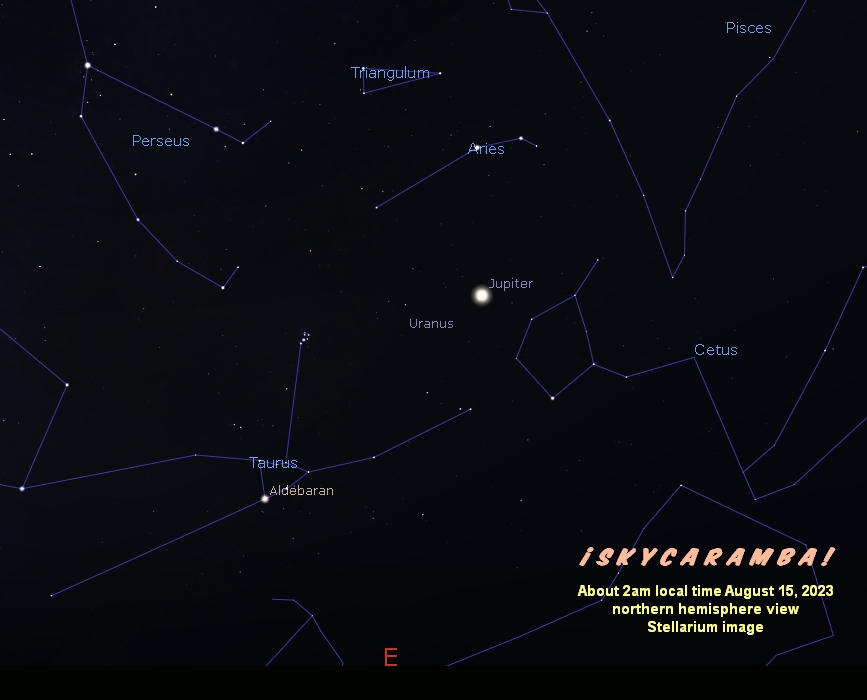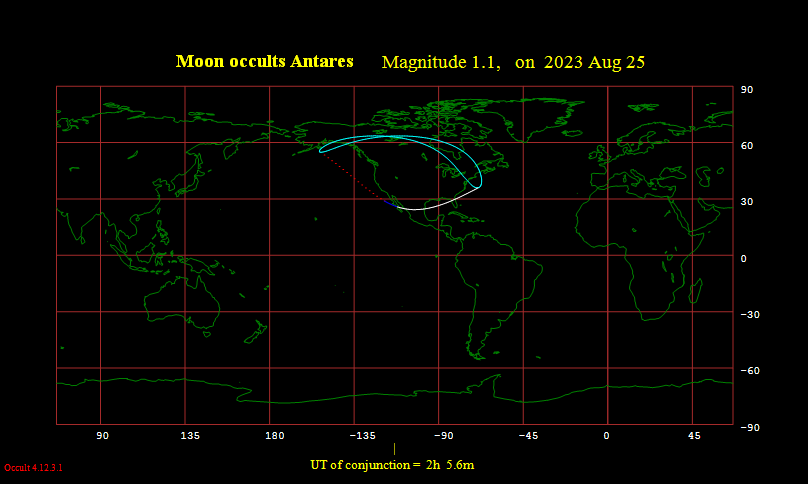The best view of the evening planets this month is from the southern hemisphere, particularly about 15 to 20 degrees south of the equator. Venus is close to the horizon after sunset when August starts. Mercury isn’t far above it. And Mars is a little higher still. They’re all in Leo. Those watching from middle and higher northern latitudes shouldn’t expect to see Venus. It will set there too soon after the sun. Mercury will be visible up to about 40 degrees north for those who have very good horizons. Mars will be visible up to around 45 degrees north.

Venus will sink into the sunset earlier each evening as it moves toward the sun. The planet will be at inferior conjunction on the 13th. You may see it toward the end of August when it moves to the morning. Meanwhile, Mercury and Mars are moving eastward through Leo. Mercury actually spends a few hours within the boundary of Sextans on the 7th. It crosses another boundary back into Leo. Of course, you can’t see the boundaries in the sky. The messenger planet is at greatest elongation on the 10th. It’s 27.4° east of the sun, about as good as it gets!
Mercury and Mars are as close as 4.7° from each other on the 13th. They’ll be below the tail of Leo. Or from the southern hemisphere, where the lion is sideways, they’ll be left of the tail.
A thin, crescent moon will visit Mercury and Mars on the 19th. The red planet is just inside Virgo’s boundaries by then. It will keep moving into Virgo and end the month close to Zaniah. Mercury is turning around in the second half of the month.

Saturn is an early-evening riser moving retrograde in Aquarius all month. It gets a visit from the moon on the 3rd and 30th. The moon is a little past full on the first visit and a little before full on the second. The ringed planet’s up all night on the 27th. Opposition distance is 8.76 astronomical units.

Jupiter rises around midnight. It’s in the boundaries of Aries but may be better described as close to the head of Cetus the sea monster. Its motion is prograde. And a last quarter moon visits on the 8th. Uranus is a little east of Jupiter. It’s about halfway between the big planet and the Pleiades.
August starts and ends with two very close full moons. Distance on the 1st is 357,510 kilometers. On the 31st, it’s 357,356 kilometers. Phases in between are last quarter on the 8th, new on the 16th, and first quarter on the 24th.
The actual closest approaches of the moon this month are on the 2nd and 30th, both at 357,200 kilometers. These are the two closest perigees of the year. Apogee is on the 16th at 406,600 kilometers. It’s the farthest apogee this year.
By some accounts, the second full moon of the month is called a blue moon. In the 1990s, Sky and Telescope investigated the expression’s origin and discovered it was a mistake published in the magazine’s own pages some five decades previous. An author in 1946 mistook the term used in The Maine Farmer’s Almanac as the one for the second full moon in a month. But the almanac’s designation referred to the third full moon in a season that had an unusual four full moons. How the magazine author made the mistake isn’t clear. That third full moon of the four-full-moon season could never be the second full moon of the month.
Other lunar position information for August: it crosses the equator northward on the 5th, reaches northern lunistice at 28.0° north on the 12th, goes south of the equator on the 19th, and reaches southern lunistice at 28.1° on the 26th.

The moon will pass in front of Antares on August 25 Universal Time. The local times for this event visible from North America will be the evening of August 24. Depending on the location, the moon will block the view of the star for up to an hour and ten minutes. For local times calculated for hundreds of cities, go to http://www.lunar-occultations.com/iota/bstar/0824zc2366.htm, pick the location closest to you, and remember to subtract the correct number of hours from UT for your time zone. Depending on how far you are from the location, the event times could be a few minutes off, so it best to look a few minutes early and keep watching a few minutes later if it hasn’t happened yet.
The event may remind you of the Mars occultation in December last year. The star is named because of its resemblance to the red planet. Ares was the ancient Greek name for Mars, and red Antares was named the rival of Mars. The late Jack Horkheimer of the PBS show Star Hustler (later Star Gazer) said he was glad that when the Romans renamed Ares to Mars they didn’t rename the star Antmars!
Venus is at aphelion on the 7th at 0.728 astronomical units from the sun.
The Perseids meteor shower’s expected peak is on the 13th. This is one of the major meteor showers. You could see up to 90 per hour depending on how dark your sky is and how much dust from Comet 109P/Swift-Tuttle the earth passes through. The moon won’t interfere much during this shower’s peak. It’s a waning crescent then. This is primarily a northern hemisphere shower, because the radiant is a far northern constellation.
The Kappa Cygnids shower peak is expected on the 18th. This is also a far northern event. It’s nowhere near as reliable or strong as the Perseids. Expect maybe three per hour at most. But some of them could be very bright fireballs. The radiant is from the western wingtip of the swan, near Kappa Cygni.


